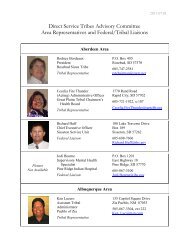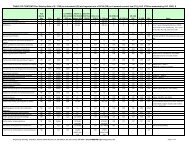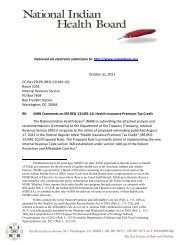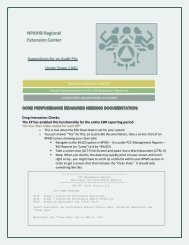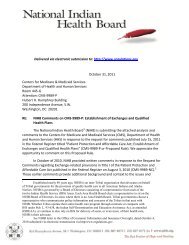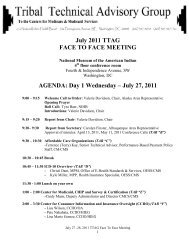mmpc - National Indian Health Board
mmpc - National Indian Health Board
mmpc - National Indian Health Board
You also want an ePaper? Increase the reach of your titles
YUMPU automatically turns print PDFs into web optimized ePapers that Google loves.
28 Final Rule, 77 Fed. Reg. 18346.<br />
v.7, 2012‐09‐23a<br />
29<br />
Wording contained in IHCIA § 4(14), ISDEAA § 4(d), and IRC § 45A(c)(6), except that the underlined word<br />
(“pueblo”) is only contained in IRC § 45A(c)(6) and the double underlined words (“or group”) are only contained in<br />
IHCIA Sec. 4(14).<br />
30<br />
This is the result because pueblos are also considered to be <strong>Indian</strong> Tribes, nations, organized groups, and<br />
communities recognized as eligible for the special programs and services provided by the United States to <strong>Indian</strong>s<br />
because of their status of <strong>Indian</strong>s.<br />
31<br />
25 C.F.R. § 900.6 (HHS and Department of the Interior (―DOIǁ) Title I), 25 C.F.R. § 1000.2 (DOI Title IV), 42<br />
C.F.R. § 137.10 (Title V). These regulatory definitions also include ―rancherias and colonies.<br />
32<br />
A significant percentage of American <strong>Indian</strong>s and Alaska Natives that seek an exemption from the tax penalties<br />
may not engage an Exchange as the AI/AN individuals may have determined not to pursue health insurance<br />
coverage. For these individuals, it is assumed attestations would be made and/or documentation would be provided<br />
directly to the IRS.<br />
33<br />
Public Law 105-33. The primary protection established is “A State may not require… the enrollment in a<br />
managed care entity of an individual who is an <strong>Indian</strong> (as defined in section 4(c) of the <strong>Indian</strong> <strong>Health</strong> Care<br />
Improvement Act of 1977 of 1976 (25 U.S.C. 1603(c)) unless the entity is one of the following [<strong>Indian</strong><br />
organizations] (and only if such entity is participating under the plan)… ”<br />
34<br />
For purposes implementing the protections afforded AI/AN in the Balanced Budget Act of 1997, see 42 C.F.R. §<br />
438.50(d)(2).<br />
35<br />
In referencing subsection (c) of section 4 of the IHCIA, this definition of <strong>Indian</strong> is more restrictive than the<br />
reference to “<strong>Indian</strong>” under the IHCIA for purposes of the special monthly enrollment period for AI/ANs enrolled in<br />
the individual market through an Exchange (authorized under ACA § 1311(c)(6)(D)).<br />
36<br />
These cost-sharing protections for AI/ANs were established under § 5006 of the American Reinvestment and<br />
Recovery Act of 2009, Pub. L. 111-5.<br />
37<br />
See 42 C.F.R. § 447.50, promulgated May 28, 2010.<br />
38<br />
The Snyder Act is the primary statute authorizing the Federal government to provide health care to <strong>Indian</strong>s and<br />
implementing the unique Federal obligations to <strong>Indian</strong>s. It directs and authorizes HHS to “direct, supervise, and<br />
expend such moneys as Congress may from time to time appropriate, for the benefit, care, and assistance of the<br />
<strong>Indian</strong>s throughout the United States” for the “relief of distress and conservation of health.” 25 U.S.C. § 13.<br />
39<br />
Medicaid Program; Premiums and Cost Sharing, 75 Fed. Reg., No. 103, pp. 30, 244, 30,248 (May 28, 2010).<br />
40<br />
Medicaid Program; Premiums and Cost Sharing, 75 Fed. Reg., No. 103, p. 30247.<br />
41<br />
For example, in a recent Section 1115 waiver application from the State of Kansas, a single operational definition<br />
of <strong>Indian</strong> was applied to both sets of <strong>Indian</strong>-specific Medicaid protections.<br />
42<br />
Federal Register, Vol. 75, No. 148, August 3, 2010, Request for Comments, “Planning and Establishment of<br />
State-Level Exchanges,” Section G. Enrollment and eligibility, Office of Consumer Information and Insurance<br />
Oversight, HHS, page 45588.<br />
43<br />
ACA § 1311 and 45 C.F.R. § 155.100.<br />
44<br />
ACA § 1413(b) and 45 C.F.R. § 155.405(a). “CHIP” refers to the Children’s <strong>Health</strong> Insurance Program under<br />
title XXI of the Social Security Act.<br />
45<br />
An additional approach to streamlining eligibility across federal programs is the implementation of a common<br />
methodology (“modified adjusted gross income”) for determining household income, as authorized by ACA § 1401<br />
/ IRC § 36B(d)(2)(B).<br />
46<br />
Conversely, as it appears to occur today under Medicaid, to simplify implementation a state or a subset of<br />
Exchange/Medicaid eligibility staff in a state might default to applying one definition for all <strong>Indian</strong>-specific<br />
purposes in a state. AI/ANs applying on one occasion or in one state may be found to be eligible whereas the same<br />
AI/ANs would be found to be ineligible on another occasion or in another state, or vice versus.<br />
47<br />
Such as grantees under the Navigator program authorized under ACA § 1311(i) or “in-person assisters”. See 45<br />
C.F.R. § 155.210.<br />
Northwest Portland Area <strong>Indian</strong> <strong>Health</strong> <strong>Board</strong> Page 15 of 16




